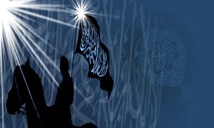
Together, the two images constitute the top banner of pages on the shabakat al-jihad al-‘alami web forum. The bottom image contains a calligraphical representation of the forum’s name and the slogan: “la ‘izza illa bil-jihad fi sabil Allah” (“there is only glory in jihad for the sake of God”). The upper image displays a horse and rider carrying a black banner. There is also a Qur’an in the background.
The black color of the banner and rider and horse elements are significant. According to prophetic tradition (hadith), the black flag was the battle flag of the Prophet Muhammad and it was carried into battle by many of his companions. The image of the black flag has been used as a symbol of religious revolt and engagement in battle (i.e., jihad). In the contemporary Islamist movement, the black flag with the shahada is used to evoke notions of jihad and of reestablishing the Islamic Caliphate.
The horse and rider motif itself is also common in jihadi visual propaganda.The rider emphasizes the element of human agency in jihad, and is a way to enhance the traditional symbol of a horse and flesh out notions of aggression and the call to jihad. The horse–an important symbol in both pre-Islamic Arabia and Islamic culture—has been ascribed with the positive qualities of chivalry, bravery in battle and victory, as evidenced in pre-Islamic poetry, the Qur’an, hadiths and other genres of literature. For example, the beginning of the Qur’anic sura 100 talks about “running horses” that appear as galloping through the world toward the final goal, namely, Judgment Day. Horses are also symbolic of the first generation of Muslims and that generation’s successful military campaigns, and thus are often employed to evoke specific Salafi religious sentiments with regard to the military victories of Muhammad and his companions. In this way, the horse motif places current jihadi activities within the same unfolding dialectic as the jihad of early Islam.
 Skip to content
Skip to content
